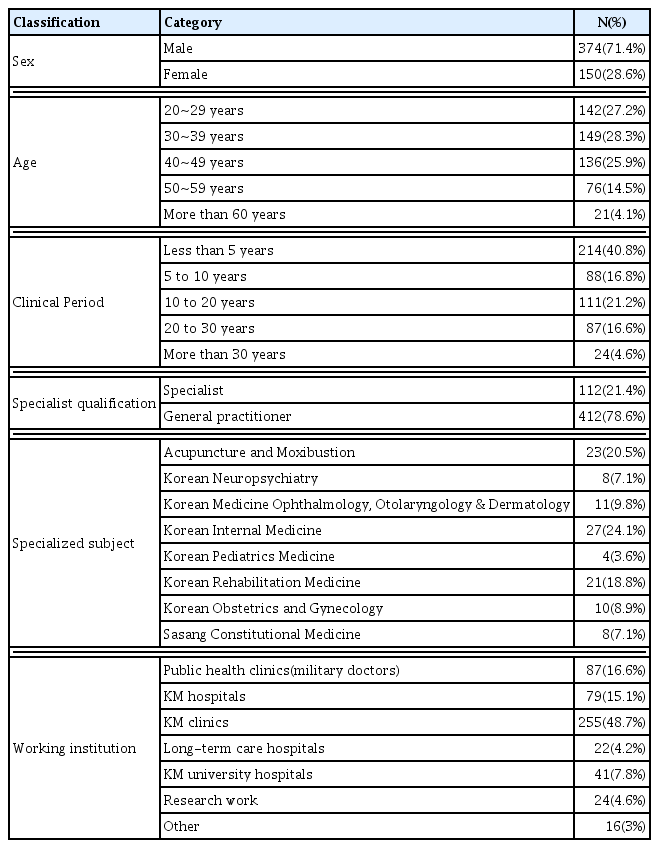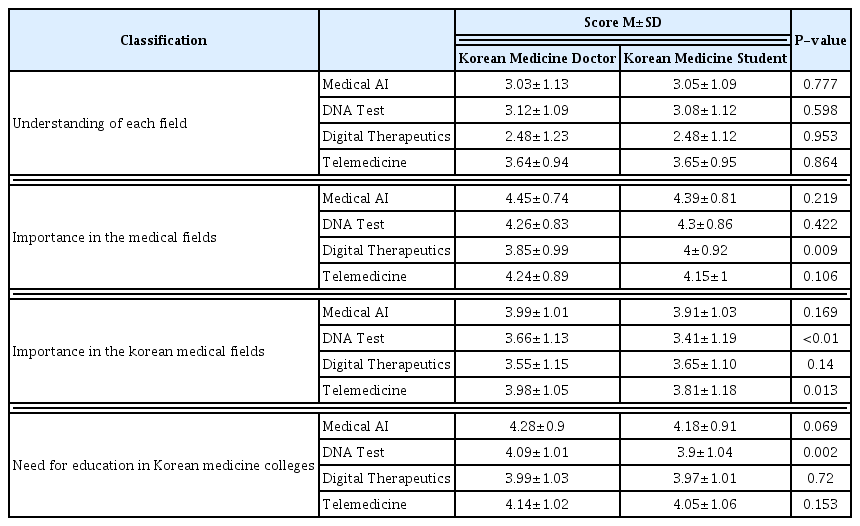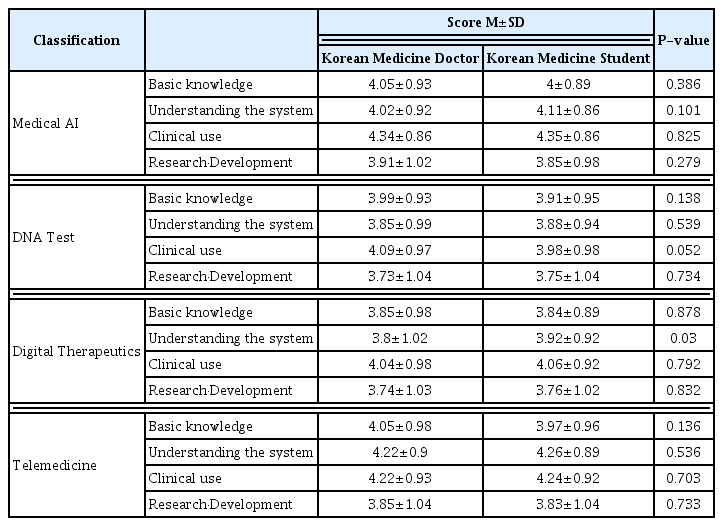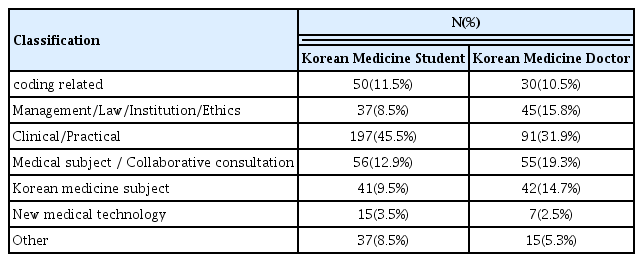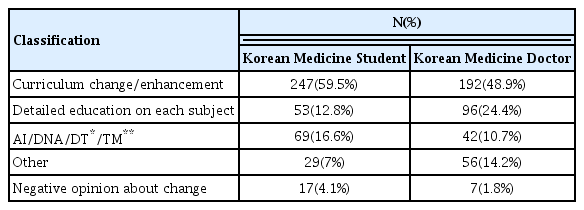The Necessity of Education in Response to Technological Advancements and Future Environmental Changes: A Comparison of Korean Medicine Doctors and Students
Article information
Abstract
Objectives
The medical field is rapidly evolving with AI and digital technologies like AI-based X-ray analysis and digital therapeutics gaining approval. Telemedicine is becoming prominent, and medical schools are adapting by integrating AI education. Pusan National University leads a talent training project for AI in health. Korean Medicine is incorporating AI with diagnostic systems and chatbots. However, there’s a lack of research on education awareness in Korean Medicine Colleges. The study aims to assess opinions on integrating AI, digital therapeutics, and DNA test into the Korean medicine college curriculum for improved education.
Methods
We selected appropriate four specific areas: artificial intelligence in medicine, digital therapeutics, DNA test, and telemedicine. The questionnaire developed for this study underwent expert evaluation and was subsequently administered to registered KMDs of the Association of Korean Medicine, as well as students from 12 Korean Medicine universities. The survey was designed to analyze the awareness and perceived importance of the 4 areas.
Results
Both KMDs and Korean medicine students exhibited comparable awareness levels across the four objectives. Notably, both groups identified a high educational necessity and importance of artificial intelligence in medicine for clinical settings. Statistically significant differences were observed between KMDs and students in their perspectives on the importance of telemedicine and DNA test in the Korean medicine field, the educational necessity of DNA test within Korean medicine universities, and the need for comprehension of regulations related to digital therapeutics.
Conclusion
The survey of Korean medicine professionals and students underscores a strong understanding of key areas such as Telemedicine, medical AI, DNA test, and digital therapeutics. Medical AI is identified as crucial for future education. There’s a consensus on the need for curriculum changes in Korean medicine schools, particularly in adapting to evolving healthcare trends. The focus should be on practical clinical application, with a call for additional research to better integrate student and practitioner perspectives in future curriculum reform discussions.
Introduction
The medical field is currently on the verge of a new wave of change. As the use of Artificial intelligence (AI) becomes more popular due to the progress of the Fourth Industrial Revolution, attempts to utilize AI in the medical field are also very active.1) In fact, in Japan, the AI-based X-ray analysis system ‘CXR-AID’ was officially certified as eligible for health insurance benefits.2) In addition, ‘Somzz’, a digital therapy device that implements ‘cognitive behavioral therapy for insomnia’ on mobile devices, was the first digital therapy device to be approved by the Ministry of Food and Drug Safety in 2023,3) and tests genes to confirm or predict a patient’s genetic disease, Based on the results, the ‘DNA test’ market, which provides genetic factors for nutrients, exercise, skin, hair, eating habits, personal characteristics, and health management to confirm information helpful for the patient’s health management, is growing.4)
These changes, of course, also apply to the form of medical treatment, and ‘telemedicine,’ or telemedicine, which provides medical care through a mobile phone application or a phone call between a medical professional and patient rather than face-to-face with the patient, is permitted only for returning patients in Korea. In line with this, medical schools are successively establishing medical convergence business groups in line with the growth potential of medical AI in order to cultivate talent with both medical artificial medicine and engineering knowledge. And they are quickly taking steps to secure related educational capabilities by reflecting this in the curriculum. For example, Pusan National University is carrying out a talent training project to respond to the demand for AI in the health and medical field based on information life convergence education at the Yangsan Campus. In addition, it has introduced a bachelor’s and master’s degree linking course so that prospective medical professionals and engineers can acquire AI medical technology at an early stage. They provided support to develop capabilities and introduced a ‘convergence major’ in which medical and engineering universities participate together.5)
Furthermore, each medical school currently has a medical information department. For example, the medical information department of Korea University Medical School will develop and operate master’s and doctoral courses, operate industry-academic projects and professional curriculums reflecting industrial demand, establish an industry-academic cooperation system, and spread performance, and train master’s and doctoral-level professionals in digital health software engineering.6) Medical schools can further improve by integrating related papers and data from similar medical schools such as the Department of Medical Information into existing research bodies.
There have also been attempts to utilize the above-mentioned technologies in the Korean medicine. Pusan National University Graduate School of Korean Medicine conducted diagnostic practice for students using the Korean Medicine Diagnosis Expert System (ODS), an expert system developed by the Electronics and Telecommunications Research Institute.7) Healthcare company Dr. Song has built an AI ‘Doctor Chatbot’ service for hospital guidance and disease consultation, and Dr. Song has built an Korean medicine coordinator AI chatbot8) for incurable and chronic skin diseases. Each time the patient’s disease improved and lifestyle variables were entered, different diagnostic results were calculated and provided to the patient.
However, the reality is that no significant changes or attempts have yet been made in terms of education. In the case of medical schools, research related to education is being conducted, such as surveying the awareness of current students9), and a similar study was conducted in the case of nursing schools.10,11) However, in the case of Korean Medicine College, no particular research is being conducted, so related information is lacking. Therefore, through this study, we investigated the awareness and educational needs of future medicine such as medical AI, digital therapeutics, and DNA test among students and Korean medical doctors at Korean medicine colleges, and surveyed their opinions on introducing related subjects into the Korean medicine college curriculum in the future. We aim to provide materials to help improve Korean medicine education.
Method
1. Research methods and subjects
For this study, a survey was conducted targeting students and current Korean medical doctors currently attending 12 Korean medicine colleges and graduate schools nationwide as of 2023. In the case of the survey for students, the online questionnaire link was distributed to each school’s KakaoTalk bulletin board to enable participation in the survey, and responses were collected from July 13, 2023 to July 27, 2023. In the case of the survey targeting Korean medicine doctors, cooperation was requested through the Korean Medicine Association and emails containing the survey content and link were sent twice to 28,234 Korean medicine doctors, from July 13, 2023 to July 27, 2023, as above. Responses were collected by the end of the day. The questions excluded duplicate answers, and were structured so that if there was no answer, the questions could not be advanced to the next question.
2. Analysis items and evaluation criteria
The questionnaire was created based on questionnaires used in previous studies related to the curriculum12), studies on medical college students11,12,13), and studies on Korean medicine doctors14). First, the basic information of the research subjects is gender, age, current school, grade, application process, and grades at the college of Korean medicine for Korean medicine students, and gender, age, clinical period, presence of specialist, specialized subject, and working institution for Korean medical doctors was investigated. Next, we investigated five comprehensive questions about four areas: medical AI, DNA test, digital therapeutics, and telemedicine. Comprehensive questions include ‘Understanding of each field,’ ‘Importance of each field in the medical field in the future’, ‘Importance of each field in the field of Korean medicine’, ‘Necessity of education at Korean medicine colleges in each field,’ and ‘Is additional training required? It was divided into ‘free opinions on necessary contents’, and the free opinions were written in a subjective manner, and the remaining four questions were ‘strongly disagree’, ‘disagree’, ‘neutral’, ‘agree’, and ‘strongly agree’. They were asked to choose one from five choices. Lastly, 5 questions were composed of questions about the need for educational content in each of the 4 fields. Among the five questions, one question asks students to express their opinion in a subjective manner about the need for education in major subjects according to future environmental changes, and the remaining four questions describe the educational content for each field, such as ‘basic knowledge’, ‘understanding of the system’, and ‘clinical utilization’. ‘Research and Development’, and the need for education for each item was indicated with five options: ‘strongly disagree’, ‘disagree’, ‘neutral’, ‘agree’, and ‘stronly agree’.
3. Statistical analysis
Frequency analysis was performed in both studies targeting Korean medicine students and Korean medical doctors. Jamovi software (version 2.2.5 for Windows) was used for data analysis, and a p-value of 0.05 or less was considered statistically significant.
4. Review of ethical issues
This survey was conducted in accordance with procedures and methods approved by the Bioethics Committee of Woosuk University Korean Medical Hospital (WSOH IRB H2307-02). Research participants were clearly informed of the purpose of the study, and informed that the survey contents would be confidential and used only for research purposes. In addition, this study is conducted based on the participant’s willingness to participate, and since it is an online survey, there is no risk involved in participating in the study. participants can freely stop responding during the survey, also can refuse to enter personal information if they do not wish to do so. The right to participate was protected by providing guidance.
Results
1. Sociodemographic characteristics (Table 1,2)
A total of 1,137 people responded to this study, of which 613 were Korean medicine students and 524 were Korean medical doctors. Daegu University of Korean Medicine had the largest number of Korean medical students (99 students (16.2%)), and Gachon University had the fewest students (17 students (2.8%)). When the 2021 Korean Korean Medicine Yearbook surveyed the number of students enrolled in Korean medicine colleges and graduate schools of Korean medicine,15) It appears to be in the same context as Daegu Korean Medicine University having the largest number of students and Gachon University having the smallest number of students. The scores within the College of Korean Medicine were 267 students (43.6%) in the upper class, 267 students (43.6%) in the middle class, and 79 students (12.9%) in the lower class, with a relative lack of responses from those in the lower ranks.
Of the 28234 Korean medicine doctors, 524(1.9%) answered. Among the responding Korean medicine doctors, 214 (40.8%) had less than 5 years of clinical experience, and 112 (21.4%) held a specialist certificate, of which 27 (5.2%) were in Korean medicine internal medicine. There were many, and Korean Medicine Pediatrics had the fewest with 4 (0.8%). Korean medicine clinics accounted for the largest number of employees at 255 (48.7%).
2. Basic understanding of each field (Table 3)
The level of understanding of each field was highest for telemedicine among Korean medicine doctors (3.64±0.94) and Korean medicine students (3.65±0.95), and for digital therapeutics, Korean medicine doctors (2.48±1.23) and Korean medicine students (2.48±1.12) were the lowest. There was no significant difference in understanding between Korean medicine doctors and Korean medicine students in all items.
3. Importance in the medical field (Table 3)
To the question, ‘How important do you expect the following fields to become in the overall medical community in the future?’, medical AI had the highest score among both Korean medical doctors (4.45±0.74) and Korean medicine students (4.39±0.81), with the score for the digital therapeutics category being the highest. Both Korean medicine doctors (3.85±0.99) and Korean medicine students (4±0.92) had the lowest scores. There was a significant difference in the expectations of the importance of Korean medicine doctors and Korean medicine students in the medical field in terms of digital therapeutics.
4. Importance in Korean Medicine (Table 3)
To the question, ‘How important do you expect the following fields to become in the field of Korean medicine in the future?’, both Korean medicine doctors (3.99±1.01) and Korean medicine students (3.91±1.03) responded that medical AI will become the most important, while Korean medicine doctors (3.55±1.15) responded that digital therapeutics would not be the most important, and Korean medicine students (3.65±1.1) responded that DNA test would not be the most important item. There was a significant difference between the opinions of Korean medical doctors (3.66 ± 1.13) and Korean medicine students (3.41 ± 1.19) in the DNA test category, and in the telemedicine category, there was a significant difference in the opinions of Korean medical doctors (3.98 ± 1.05) and Korean medicine students (3.81 ± 1.18).
5. Necessity of education in Korean medicine colleges (Table 3)
To the question, ‘Do you think each field will require education at Korean medicine schools in the future?’, both Korean medicine doctors (4.28±0.9) and Korean medicine students (4.18±0.91) responded that medical AI has the highest need for education, while Korean medicine doctors (3.99±0.91) 1.03) rated digital therapeutics as having the least need for education, and Korean medicine students (3.9±1.04) rated DNA test as having the least need for education. There was a significant difference in the opinions of Korean medicine doctors (4.09±1.01) and Korean medicine students (3.9±1.04) in the DNA test items. Table 4. The need for education of educational content in each field.
6. Education needs of educational contents in each field (Table 4)
As a result of investigating the need for education in each field, we divided the educational content in each field into four categories: basic knowledge including subject-related terminology, technology development status, mechanisms and principles, system understanding, clinical use, and research and development. As a result, we investigated the educational needs of each item. In both Korean medicine doctors (4.34±0.86) and Korean medicine students (4.35±0.86) gave the highest score to the clinical utilization item, and both Korean medicine doctors (3.91±1.02) and Korean medicine students (3.85±0.98) gave the lowest scores to research and development. In DNA test, both Korean medicine doctors (4.09±0.97) and Korean medicine students (3.98±0.98) gave the highest scores to the clinical use item. Both Korean medicine doctors (3.98±0.98) and Korean medicine students (3.75±1.04) gave the lowest scores to research and development.
For digital therapeutics, both Korean medicine doctors (4.04±0.98) and Korean medicine students (4.06±0.92) gave the highest scores to clinical use items, and both Korean medicine doctors (3.74±1.03) and Korean medicine students (3.76±1.02) gave the lowest scores to research and development. There was a statistically significant difference in the opinions of Korean medical doctors and Korean medicine students regarding the need for education on system understanding.
In telemedicine treatment, Korean medicine doctors gave the highest scores to system understanding (4.22±0.9) and clinical utilization (4.22±0.93), and Korean medicine students gave the highest scores to system understanding (4.26±0.89). Both Korean medicine doctors (3.85±1.04) and Korean medicine students (3.83±1.04) gave the lowest score to the research and development item.
7. Contents currently requiring additional education at Korean Medicine College (Table 5)
To the question, ‘Except for the four above, please feel free to write about the contents that require additional education at the College of Korean Medicine,’ 433 Korean Medicine students and 285 Korean Medical Doctors responded, and for Korean Medicine students, the main answer field was clinical/practical (45.5%), Western medicine subject reorganization/collaboration (12.9%), AI/coding related (11.5%), Korean medicine subject reorganization (9.5%), management/law/systems (8.5%), new medical technology (3.5%), and other opinions (8.5%) %) was there. In the case of Korean doctors, clinical practice/practice including imaging, diagnosis, emergency, etc. (31.9%), reorganization/collaboration of Western medicine subjects (19.3%), management/law/systems/ethics (15.8%), reorganization of Korean medicine subjects (14.7%), This was followed by AI/coding-related (10.5%), other opinions (5.3%), and new medical technology (2.5%).
8. Free opinions on the survey (Table 6)
To the question, ‘Please feel free to write your opinion on the need for education in major subjects according to future environmental changes’, 415 Korean medicine students and 393 Korean medical doctors responded. The main answer area of Korean medicine students was the reform/strengthening of the overall curriculum (59.5%), AI/DNA test/digital therapeutics/telemedicine-related education (16.6%), Detailed education on each subject such as Western medicine, clinical practice, and medical systems (12.8%), and other opinions (7%). There were also negative opinions (7%) regarding the introduction of desired or new subjects.
In the case of Korean medicine doctors, overall curriculum reform/strengthening (48.9%), Detailed education on each subject (24.4%), other opinions (14.2%), AI/DNA test/digital therapeutics/telemedicine (10.7%), negative opinions (1.8%) followed.
Discussion
The survey used in this study was divided into four parts: comprehensive questions, free opinions on contents requiring education, two groups’ evaluation of the need for education by content in each of the four fields, and free opinions on education in major subjects. Opinions were surveyed.
Korean medicine doctors and Korean medicine students showed a high level of understanding of telemedicine, but their understanding of medical AI and DNA test was ‘neutral’, and their understanding of digital therapeutics was low. The high level of understanding of telemedicine can be easily experienced directly because telemedicine is still allowed only for returning patients after the COVID-19 pandemic16) and the content and effects of telemedicine are learned through media such as news or related research 17,18). It is thought that this is because information about can be obtained. Conversely, the reason for the low understanding of digital therapeutics appears to be that digital therapeutics has only recently been commercialized in Korea. In February 2023, the insomnia treatment digital therapeutics ‘Somzz’ was approved as Korea’s first ‘digital therapeutics’, which is only about 5 months old as of July 20233) when the survey was conducted. In the “Digital therapeutics Doctors’ Awareness Survey” conducted on 1,008 Medigate doctor members on August 8, 202219), The prevailing answer to inquiries regarding comprehension and introduction to digital therapeutics was ‘I am uncertain, but I maintain a positive outlook’. This is consistent with many results.
The predicted importance of the four fields in the medical field was highest for medical AI for both Korean medicine doctors and Korean medicine students. This is thought to be because research and discussions on medical AI in the healthcare field are currently active. In fact, a survey study has been conducted on students in health and medical fields such as nursing schools in Korea11), and each medical school is making various efforts to train medical personnel with the ability to use AI.5) The item rated as least important for both groups was digital therapeutics, which appears to be for the same reason as the low understanding previously. In the digital therapeutics category, Korean medicine students gave higher scores than Korean medical doctors, showing a significant difference. This was judged to be due to the difference in age between the two groups. In fact, there is research showing that there is a digital gap by generation among teenagers, the MZ generation, and people in their 40s and older20), and most Korean medicine students are of a younger generation than Korean medical doctors. Therefore, it appears that they were given higher scores because they were more familiar with digital devices and technology.
Korean medicine doctors and Korean medicine students’ predictions of the importance of the four fields of Korean medicine were generally similar to the survey questions about the importance expected in the medical field. However, there was a difference in that Korean medicine students rated DNA test as the least important, and Korean medicine doctors gave higher scores than Korean medicine students in the telemedicine and DNA test categories, showing a significant difference. The reason for the significant difference between DNA test and telemedicine appears to be due to the presence or absence of clinical experience. This is in the same context as Park et al. expected that clinicians in the survey felt the need for osteology practice higher than medical school students because osteology practice was useful in treating patients.21) In fact, in clinical practice of Korean medicine, DNA test is applied to treat obesity and chronic fatigue, and recently, a ‘customized health functional food pilot project’ through DNA test, etc. is being conducted at Korean medicine medical institutions under the supervision of the Korean Medicine Association.22) Telemedicine is currently provided by Korean medicine doctors in clinical settings only for returning patients, and a survey conducted on Korean medicine doctors regarding the introduction of telemedicine was generally positive toward the introduction of domestic telemedicine and Korean medicine telemedicine17).
The evaluation of the need for education in four areas by Korean doctors and Korean medicine students showed overall similar response results to the expected importance of the 4 fields in the Korean medicine field, and in the DNA test section, Korean doctors gave higher scores than Korean medicine students, showing a significant difference. The reason appears to be the same as the reason why there was a significant difference in the predicted importance in the Korean medicine field.
In the categories of medical AI, DNA test, and digital therapeutics, most Korean medicine students and Korean medical doctors had the highest scores for education related to clinical use and the lowest for education related to research and development. Looking at the results showing that all results are distributed around an average of 4 points, we can see that all four items are considered important. In the field of telemedicine, unlike the other three fields, both Korean medicine doctors and Korean medicine students considered education related to system understanding to be the most important.
Regarding telemedicine, as there are differences of opinion in the policy process not only among government officials and medical workers, but also among medical workers 23), consultations between the parties have continued, and since the policy may be modified in the future, related systems must be established to avoid legal battles. It seems important to educate accurately.
Regarding areas that require additional education in addition to the four subjects, it can be seen that both current students and Korean medical doctors most want to strengthen education in the clinical/practical field, especially radiology and diagnostic equipment. This is based on a survey of Korean medicine students’ perceptions of Korean medicine education. This is consistent with the results of a previous study22) showing that 77% of Korean medical doctors agreed with the opinion that modern medical devices should be used.
In addition, there was a recent Supreme Court unanimous decision to allow Korean medicine doctors to use ultrasound diagnostic devices24), and as electroencephalography and low-dose X-rays are permitted25), the need for training related to diagnostic devices is expected to increase. In addition, the reorganization/collaboration of two-way subjects, AI/coding-related, reorganization of Korean medicine subjects, and management/law/systems/ethics subjects were distributed in similar proportions.
Regarding the need for education in major subjects, most Korean medicine students and Korean medical doctors believe that the curriculum of Korean medicine schools should change to suit the changing environment in the future, and there seem to be very few opinions that maintaining the current curriculum or introducing new subjects is unnecessary. This is a similar result to previous studies25) showing that satisfaction with the curriculum was not high.
There were many opinions about the need for Detailed education on each subject such as clinical, Western medicine, and medical systems, which were mentioned in the previous subjective survey. There were also quite a few opinions that education related to AI/DNA test/digital therapeutics/telemedicine is necessary.
This study surveyed the perceptions of Korean medical doctors and Korean medicine students regarding four subjects that could be considered for introduction into the Korean medical school curriculum, and synthesized opinions on other subjects that require education and the need for education in major subjects, suggesting the need for education. It is significant in that it suggests direction.
However, in this study, only 624 Korean medicine students and 524 Korean medicine doctors responded to the survey, making it difficult to generalize due to the limited sample. In particular, in the case of Korean medical doctors, the response rate from Korean medical doctors with less than 5 years of clinical experience reached 40%, which is a limitation in that it does not reflect the opinions of all Korean medical doctors. Additionally, in the case of subjective opinions, there is a limitation in that it is difficult to reflect each individual’s opinion in that a large number of opinions are classified according to subjective standards and expressed as a ratio. However, the curriculum of Korean medicine schools is changing rapidly due to KAS2022, etc., and the fact that many of the opinions of Korean medicine doctors who graduated relatively recently are reflected can be an advantage of this study. It is believed that follow-up research that supplements the limitations of this study, such as diversifying questions depending on clinical experience or focus group interviews, is needed.
Conclusion
As a result of conducting a survey of students attending 12 Korean medicine colleges and graduate schools of Korean medicine nationwide and current Korean medical doctors, the following conclusions were obtained.
Korean medicine doctors and Korean medicine students generally showed a high level of understanding in the order of telemedicine, medical AI, DNA test, and digital therapeutics, and chose medical AI as a subject that will become important in the Korean medicine field in the future and requires education. Clinical application education was considered the most important for the four subjects presented in the paper, and as a result of investigating educational fields other than the four subjects, there were many opinions related to clinical practice education, especially education on modern diagnostic equipment. Most Korean medical doctors and Korean medicine students thought that the curriculum of Korean medicine schools should change.
Considering the opinions of Korean medicine doctors and Korean medicine students, it seems that the curriculum of Korean medicine schools needs to change in response to the rapidly changing future, and in particular, education related to clinical practice, such as modern diagnostic equipment, needs to be strengthened. The fields of medical AI, telemedicine, digital therapeutics, and DNA test are all related to future technology and clinical trials, and according to survey results from both Korean medicine students and Korean medical doctors, these are subjects that showed high educational requirements and may be worth considering adding to the curriculum.
When introducing each subject, it seems important to structure the curriculum so that it can be used in actual clinical practice. I hope that more related surveys and research will be conducted so that the perceptions of students and Korean medicine doctors can be well reflected in future discussions on curriculum reform.
Notes
Conflicts of Interest
The author declare that there is no conflict of interest regarding the publication of this paper.


